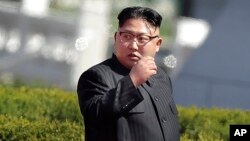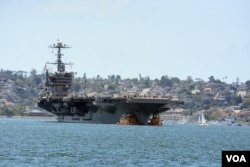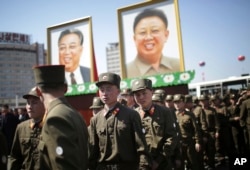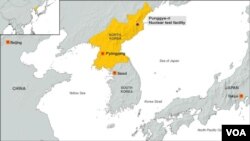North Korea’s military on Friday directly responded to U.S. President Donald Trump’s renewed threats to take "care of" Pyongyang’s nuclear threat amid expectations of a new nuclear test that could come at any time.
"Our toughest counteraction against the United States and its vassal forces will be taken in such a merciless manner as not to allow the aggressors to survive," according to an unnamed spokesman for the General Staff of the Korean People's Army.
"Under the prevailing grave situation, the United States has to come to its senses and make a proper option for the solution of the problem," continued the statement, which was initially carried by the country's official Korean Central News Agency and later broadcast by Pyongyang's central radio station.
VOA queried the White House press office and National Security Council regarding the latest comments from North Korea, but received no response.
A day earlier, Trump had responded to reports that North Korea was poised to detonate an underground nuclear device as early as Saturday to mark the anniversary of the birth of the nation's founder, Kim Il Sung.
“North Korea is a problem,” Trump said at the White House. “The problem will be taken care of.”
The North Korean military statement, issued late Friday in Pyongyang, said the "Trump administration's serious military hysteria has reached a dangerous phase which can no longer be overlooked."
The statement emphasized that any encroachment of North Korea's dignity or sovereignty by provocative actions by the United States would be mercilessly foiled with "Korean-style toughest counteraction."
It did not elaborate, but previous warnings have included threats to attack Seoul and U.S. military bases in South Korea, the Pacific and even the mainland United States.
Such rhetoric from North Korea is fairly common, but statements emanating from the military command are taken more seriously by intelligence and defense analysts than those that come from government ministries or frequent commentaries in the state media.
China's efforts
While Trump’s remark was taken as a threat of military action against the North, the president added that China “is working very hard” to defuse the international tension over North Korea, and that he was hopeful Beijing’s diplomacy would be effective.
In a separate comment earlier Thursday, however, Trump said the United States was prepared to tackle the North Korean crisis without China, if necessary.
China’s foreign ministry on Friday described the current situation on the Korean Peninsula as “complex and sensitive.”
“We have appealed to relevant various parties multiple times to keep calm and exercise restraint, not make moves that may heighten tensions of the peninsula. All the similar acts are irresponsible and also are dangerous,” spokesman Geng Shuang told reporters in Beijing.
An American aircraft carrier and other warships have been steaming toward the Korean Peninsula in a show of force, although there has been no specific U.S. threat of retaliatory action if Pyongyang conducts another nuclear test or launches more missiles in defiance of U.N. sanctions.
China is North Korea’s sole major ally, but it opposes Pyongyang’s nuclear weapons program, along with all other neighbor states.
At the Pentagon, U.S. Defense Secretary James Mattis said Washington was “working with international partners in order to defuse the situation, but the bottom line is, North Korea has got to change its behavior.”
Device in tunnel at nuclear test site
Amid the rhetoric from all sides, no information has emerged to challenge the news reports from earlier this week: North Korea appears to have placed a device in a tunnel at its nuclear test site that could be detonated Saturday or even sooner. VOA’s report, quoting U.S. government and other sources with that story Wednesday, was updated Thursday by a source within the U.S. intelligence community: “U.S. intelligence is always on the alert for a possible North Korean weapons test. Kim Jong Un wants his country to be validated as a nuclear power, and a test would further that goal.”
Scores of foreign journalists are in Pyongyang this week for North Korea’s biggest national holiday, the “Day of the Sun” Saturday, marking the 105th anniversary of the birth of Kim Il Sung, North Korea’s founder and the grandfather of the current ruler.
Five years ago, the late Kim Il Sung’s centenary was marked by a failed attempt to launch a North Korean space satellite, and last year Pyongyang tested a newly developed intermediate range missile — also a failure.
Satellite photographs this week have shown continuing activity around the North’s nuclear test site, which could be taken to indicate another underground nuclear test is imminent.
Although South Korean and American troops are preparing for a round of joint military exercises — a regular event that Pyongyang has denounced as preparations for an invasion that would justify a massive counterattack — a spokesman for the South Korean joint chiefs of staff said Thursday that Seoul had seen no indications any military action by the North was imminent.
Pompeo on North Korea
CIA Director Mike Pompeo told a security forum in Washington that North Korea’s military development had progressed to a point where Pyongyang was now closer than ever to being able to threaten the United States with a nuclear-tipped intercontinental missile. That, in turn, has reduced U.S. defense officials’ options about how to respond to the North Korean threat, Pompeo added during remarks at the Center for Strategic and International Studies.
He indicated that a worst-case scenario would force the U.S. to act against the North, and that would be “a tough day for the leader of North Korea.”
Discussion this week about possible U.S. military action against the North has referred to the cruise missile strike against a Syrian airbase that Trump ordered last week, and the mammoth single bomb airstrike an American warplane carried out Thursday against an Islamic State bunker complex in northeastern Afghanistan, near the Pakistani border.
News that the U.S. had dropped the most powerful non-nuclear bomb in its arsenal, a 10,000-kilogram explosive that headline writers called “the mother of all bombs,” was taken as a message directed at Kim Jong Un. Trump brushed off questions about whether the bombing was a message for Pyongyang, but he stressed his feeling that North Korea was “a problem that will be taken care of.”
VOA's Pentagon correspondent Carla Babb and national security correspondent Jeff Seldin contributed to this story.














